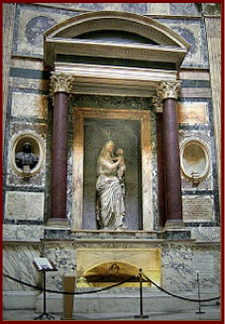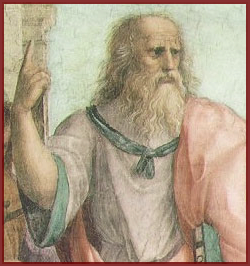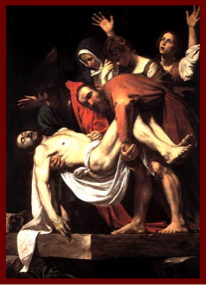Dr. Utr. Iur.
Frank
Van den Broeke
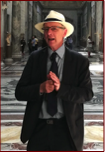
To book an authorised guided tour with me: .... Click here
Wine & Dine: ... Click here
Where to buy your tickets ... ? Click here
Gold is gone ... for ever ?!
We are coming in the era of humanism: Man is becoming the centre of the world, made after God. No images more of a super-natural world, but scenes what happens hic et nunc, here and in this time.
In this transit-time, without the gold of the past, we still see idealised figures, and the Idea/Message (Plato) is more important than the reality.
From Perugino to the 19th century
Room 7: Perugino
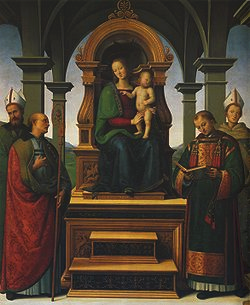
Pala dei Decimviri, Perugino:1495-96
H.V. Morton, in his book "A Traveller in Italy", gives you a nice description of the violent life in the city of Perugia and the life of Perugino (1446/50 - 1523) Also Vasari in his "Life of Artists" has a lot of insight in the life of Perugino (born: Pietro di Christoforo Vannucci)
And speaking of his beautiful Madonnas he painted, Berenson wrote: "He had a felling for beauty i women as 'tall, slender, golden-haired, daubbtt - Shakespeare's heroines in disguise. Then there is a well-ordred seemliness, a santuary aloofness in all his people which makes them things apart, untouched and pure".
Perugino, self-portrait, Sistine Chapel: the Vocation of Moses
In his works, it seemed that he is still hanging in the old school of over-piety beautifull Madonna's. It is said that he made all women of Perugia jaleous in the way he dressed and hairstyled his wife: he must have been also an excellent barber.
But something is already different: the gold is gone !! It is possible that the reaction of Savonarola against the exuberant lifestyle of the clergy (pope Borgia, Alexander VI), made that painters of those years became less opulent. We are indeed only a few years away of the official protest of Martin Luther.
Room 8: Raphael
Vasari tells us the following about the Transfiguration:
For Giulio de' Medici, Cardinal and Vice-Chancellor, he painted a panel picture, to be sent into France, of the Transfiguration of Christ, at which he labored without ceasing, and brought it to the highest perfection with his own hand. In this scene he represented Christ Transfigured on Mount Tabor, at the foot of which are the eleven Disciples awaiting Him. There may be seen a young man possessed by a spirit, who has been brought thither in order that Christ, after descending from the mountain, may deliver him; swhich young man stretches himself out in a distorted attitude, crying and rolling his eyes, and reveals his suffering in his flesh, his veins, and the beat of his pulse, all infected by that malignant spirit; and the colour of his flesh, as he makes those violent and fearsome gestures, is very pale. This figure is supported by an old man, who, having embraced him and taken heart, with his eyes wide open and the light shining in them, is raising his brows and wrinkling his forehead, showing at one and the same time both strength and fear; gazing intently, however, at the Apostles, he appears to be encouraging himself by trusting in them. Among many women is one, the principal figure in that panel, who, having knelt down before the Apostles, and turning her head towards them, stretches her arms in the direction of the maniac and points out his misery; besides which the Apostles, some standing, some seated, and others kneeling, show that they are moved to very great compassion by such misfortune. And, indeed, he made therein figures and heads so fine in their novelty and variety, to say nothing of their extraordinary beauty, that it is the common opinion of all craftsmen that this work, among the vast number that he painted, is the most glorious, the most lovely, and the most divine. For whoever wishes to know how Christ Transfigured and made Divine should be represented in painting, must look at this work, wherein Raffaello made Him in perspective over that mount, in a sky of exceeding brightness, with Moses and Elias, who, illumined by a dazzling splendor, burst into life in His light. Prostrate on the ground, in attitudes of great beauty and variety, are Peter, James, and John; one has his head to the earth, and another, shading his eyes with his hands, is defending himself from the rays and intense light of the splendour of Christ. He, clothed in snow white raiment, with His arms outstretched and His head raised, appears to reveal the Divine essence and nature of all the Three Persons united and concentrated in Himself by the perfect art of Raffaello, who seems to have summoned up all his powers in such a manner, in order to show the supreme force of his art in the countenance of Christ, that, after finishing this, the last work that he was to do, he never again touched a brush, being overtaken by death.
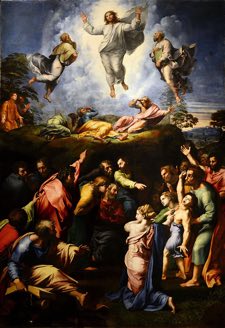
This was the last work produced by Raphael, founded back in his workshop after his premature dead at the age of 36 years. He died in 1520 and got burried in the Pantheon on his own request.
In the desk in front of the painting, we can see some of the earlier works of Raphael. In those works he is still under the influence of his teacher Perugino.
This vivid portrayal of human emotion - inspired in part by the Adoration of the Magi (1481, Uffizi Gallery, Florence) by Leonardo da Vinci, and by Titian's Assumption of the Virgin (1518) - influenced many other High Renaissance artists, and - along with the Last Judgment fresco on the altar wall of the Sistine Chapel, by Michelangelo - may be said to have paved the way for the even more expressionistic style of Mannerism. Indeed, some art experts consider that the dramatic tension contained within Raphael's figures, allied to his strong use of chiaroscuro, prefigures the coming style of Baroque painting.
In his famous book Lives of the Artists (1550), the Florentine Mannerist artist and biographer, Giorgio Vasari (1511-74), wrote that The Transfiguration was Raphael's "most beautiful and divine" work. Insofar as the painting (1) promotes the Church - by exalting the redemptive power of Christ, while reminding us of the flaws of man - (2) pays due regard to the creative efforts of the artist's predecessors, and (3) foretells the future development of 16th-century art, one might easily agree with him. On the other hand, one might say that the very emotionalism which makes this work so progressive (one might say its Mannerist Painting tendency) conflicts to some extent with Raphael's signature style of calm gracefulness and harmony of balance, embodied, for example in The School of Athens (1509-13, Stanza della Segnatura, Vatican) - as well as other works in the Raphael Rooms - and The Sistine Madonna (1513-14, Gemaldegalerie Alte Meister, Dresden).
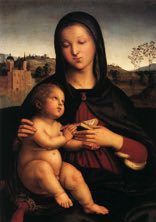
Raphael Madonna Pasadena
But why gold is gone? Even the haloes ! Maybe the answer we can find in the political world that surrounded Perugino. He worked during the years of one of the most infamous popes: Alexander VI, Borgia, who had four legitimite children and it is said over thirty illegitimite. Clearly, women didn't go to bed with him for his beauty ! And even the children had a reputation: from Lucrezia is said that she was a hooker and even in bed with her father .... Cesare Borgia, il Duco Valentino, nothing more than a serial killer ... Insomma, a pope of terror. Simony was the rule. A lot of money was needed for mantaining such a numerous family. And protest broke out. People started to stand up against what we are calling today "the Establishment". In Florence, a monk stood up -Savonarola- and insisted in a violent way a reform of the top of the Catholic Church. God alone would be the king in his new Civitas Dei - A City for God! And like today, when there is a crisis, the rich try to hide their wealth. On the Beverly Hill the Fiat Cinquecento stands in front of the villa's, while in the garage is the Rolls Royce !
Something similar happened in the arts: the paintings still have to offer a Heaven where you will eat rice with golden spoons, and only through the Catholic Church you can obtain it ... but with the indulgency-money that came in (and very much needed for such a large family as the Borgia's), painters like Perugino are starting to take the glitter and opulence away.
People don't have to see the ostentation of the clergy. Some change was in the air !


Pope Alexander VI Borgia (1494-1503) Pinacoteca Vaticana
On Raphael's tomb in the Pantheon is a beautiful text: Ille hic est Raphael, timuit quo sospite vinci rerum magna parens et moriente mori.
"Here lays Raphael, during lifetime she (rerum magna parens - the mother of all nature) was jealeous (Raphael was so much better in creating), but after his death, She had the feeling a part of Herself died together with him.
We are the year 1520. A real shock went through the Catholic Church. Martin Luther started in 1517 his official protest against the Establishment and the Hiarchy of the Roman Church. The invention of the printing by Guttenberg made that the new ideas reach the whole of Europe in a minimum of time.
The anger of the base found an outlet in a new manner of painting: a style that will be called manierism. Clearly, in this work we can see the strong influence of Michelangelo, who was the first who in his works and his corrispondence with Vittoria Colonna showed that "Grace" is coming from God to every human being and not only by the hiearchy of the Catholic Church, that is only an instrument, but not the final cause to obtain it.
What happened in the world that surrounded Raphael, that his style changed so dramatically ?
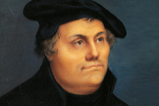
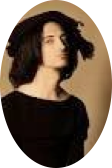
Raphael Selfportrait
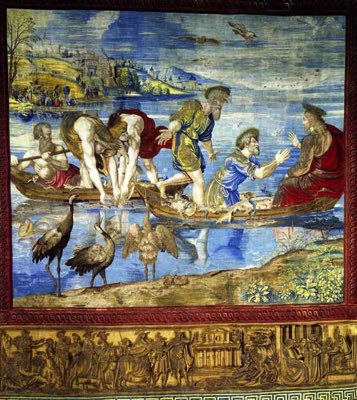
Ten beautiful tapestries (follow the link) of the School of Pieter van Aelst are surrounding the Transfiguration of Raphael.
Pope Leo X ordered Raphael in 1515 to make 10 cartoons for tapestry, to be used in the lower level of the Sistine Chapel. They are representing the life of Saint Peter & Paul. It couldn't have been an easy task for Raphael, knowing that he had to compete with the vault of Michelangelo.
They are for sure among the best ever produced in history. They had a double function: first of all decorative (they were hanged up for the first time on St. Stephen's Day in 1519). The other function is creating an airspace behind that doesn't move and in such a way creating an insulation. Just like the Bedouins in the desert are using tapestry for keeping the heat out, it keeps the room warmer in the winter. Espescially if we know that the woodburner in the Sistine Chapel is only used for making black and white smoke ....
© Copyright, 2008-2016, by Vincent Finnan, Italian-Renaissance-Art.com : the Miraculour Fishing
Of course, the one that is the eyecatching is the interpretation of the Last Supper of Leonardo da Vinci (Santa Maria delle Grazie - Milano 1495-1498). And please, forget all the stories made up by Dan Brown in his Da Vinci Code. It's a masterpiece of Italian Renaissance and inspired thousands of artists.
And that brings me to the next, small room, where we have alongside the Lament over the dead Christ of Bellini, an original work of Leonardo da Vinci.

Room 9: Leonardo da Vinci and Giovanni Bellini
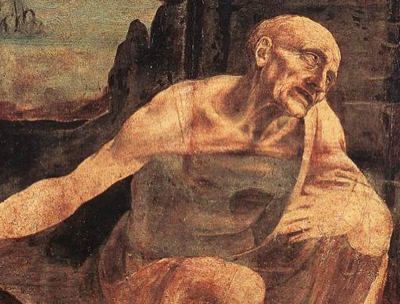
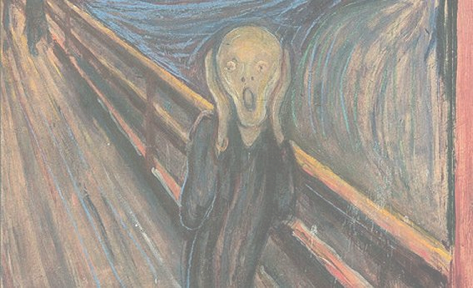
Edward Munch, the Scream as layer over St. Jerome in the desert, Vativan Museum, Leonardo da Vinci
I was walking along the road with two Friends
the Sun was setting — The Sky turned a bloody red
And I felt a whiff of Melancholy – I stood
Still, deathly tired – over the blue-black
Fjord and City hung Blood and Tongues of Fire
My Friends walked on – I remained behind
- shivering with Anxiety – I felt the great Scream in Nature
Written by Edward Munch on the back of the 4th version
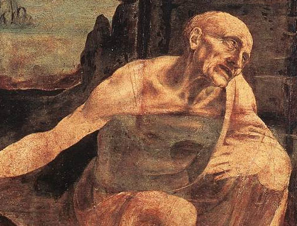
Sometimes, we have that déjà-vu feeling. It happened when I saw for the first time the meditation of St. Jerome in the desert by Leonardo da Vinci (1482). The typical Leonardesque background with glaciers and remote mountains evoces the feeling expressed in the work work of Edward Munch, the Scream. Reading the poetry of Munch, written on the back of the 4th version can only rinforce that sentiment. The expression of St. Jerome is maybe that of a man who got aware of the power of the Divine!
The whole discussion if Leonardo was an artist or scientist, is already described in the introduction of my weblog. He lived in a world where "man" became central. The humanity of Christ came central ... his divinity got on the background. In a certain way we can feel in St. Jerome the passion of Christ. To understand the psyche of St. Jerome, Leonardo studied the human body and tried to express physically what St. Jerome was feeling, being alone in the desert.
The study of the anatonomy of the body was only a vehicle to express an idea. He was for sure a platonist and nòt an aristotelian. And therefore, Raphael used his face for Plato, the man of Ideas, not of Physics.
But his studies would pave the road for those who came after him: Titian, Veronese, Vasari, Caracci and before Michelangelo and Raphael.
Some of those painters we find in the next room.
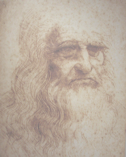
Selfportait of Leonardo as a layer over Plato in the School of Athens by Raphael in the Vatican
Room 10: Titian and Veronese - Venetian School
"The Madonna of San Niccolo dei Frari," the Virgin with Child and Sts. Catherine, Nicholas, Peter, Anthony, Francis & Sebastian; high altarpiece of the church of San Nicoletto by Titian, 1533-35, now in the Pinacoteca of the Vatican Museums
Photo: The Saint Bede Studio Blog
Especially the figure of St. Sebastian on the right is extremely powerfull. Also in the next room we will find the martyrdom of St. Sebastian. And also there we will find that expression of happiness on the face. Not that that would be my expression if I got hit by seven arrows!
But you have to understand the context: we are only a few years after that Rome was sacked in 1527. Catholics and Protestants stood fiercely against each other. becoming a martyr for the good cause was the highest you could claim for. And Paradise was waiting for you.
Today we see happening the same in the Muslimworld. Those who die as martyr will receive a special premium of vergins in heaven. The Catholic church has still it's martyrs today - Syrie, Libanon, the Copts etc. But the main difference is that you can't become a martyr by blowing up yourself and killing others in the name of God. Something that also happened by the hands of the Catholic Church (the crusades).
The whole turmoil between heresy and doctrine of the Catholic church made the fertile ground for rethinking the Catholic faith and prepared the street for the Council of Trent. That this Council would have a major impact on the arts can't be denied. Room 11 will show us the first changes in art.
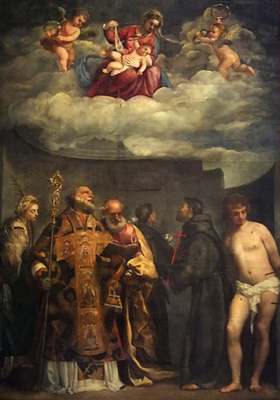

Room 11: Vasari-Carracci-Cavalier d'Arpino- Federico Barocci (1528-1612)
In the begining of protestantism, che Church was reluctant to listen, and the Establisment went on as before. But as it happens today in politics, grass-rooted movements are powerful! And the Roman catholic church didn’t change from the top, it started on the base. Suddenly, charismatic movements started within the catholic church: the Theatines of Gaetano dei Conti di Tiene whose chief object was to recall the clergy to an edifying life and the laity to the practice of virtue. And there were also the Gesuits of Ignazio di Loyola, who took care of the orphans, male ànd female, the Barnabites, who concentrated their vocation around ministrations in hospitals and prisons, and the education of the youth. And not to forget the Oratorians of St. Philip Neri, who with his bizarre character became the spiritual dean of them. All those people were persecuted by the Church in their early years, but their grass-rooted movements changed the Church and forced it to call together the Council of Trent, (full text) in order to change the mentality of the church in the top. This council lasted eighteen years. It started on December 13, 1545 and ended on december 4, 1563. In total twenty-five sessions in three periods. Often this is mistakenly called the Counter-Reformation, but the proper name is the “Catholic Reformation”: The Church changed from the bottom to the top and put salvation before wealth. It was the intellectual counter-force to Protestantism
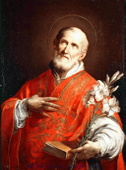
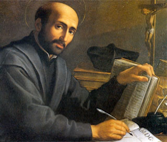


San Philipp Neri
Sant'Ignatius of Loyola
San Felice da Cantalice (Rubens)
San Gaetano da Tiene(Naples-statue)

Saint Charles Borromeo
It is in this context that we have to look at the painters of this room. They were all painters of the Catholic Reformation: art became a vehicle for the re-education of the faithfull. The successor of Saint Philip Neri, Cesare Baronio wrote the Annales Ecclesiastici, taking out the platonic elements of the life of saints: all the elements that were pure fantasy were tooken out. Only through the way they answered the call of God and put it in practice by real deeds of charity was acceptable in his eyes. Luther was right when he claimed that the supernatural powers of saints by miracles made them ... and their relics who were for sale ... more important than Christ himself.
Even today we can see in Naples that the power attributed to the blood of San Gennaro is a more potent magic force than Christ ever had Himself. Cesare Baronio and the reformers of his time saw in the lifestyle of saints and the institution of the Catholic Church only a way that conduct us to Christ and not an end in itself. Your daily deeds can bring you to santity !!

Venerable Cesare Baronio, successor of Saint Philipp Neri, Chiesa Nuova - Roma
A painter for which I have a special affection is Federico Barocci. His colorpalet is superb ! It is said that saint Philipp Neri had levitations in extasy in fronto of his work, the Vistation of Elisabeth in the Chiesa Nuova.
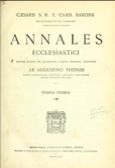

Federico Barocci (c. 1526 in Urbino – 1612 in Urbino)

Visitation Federico Barocci 1586 - Chiesa Nuova - Roma
But his work I want to describe here is the Rest in Egypt.
Federico Barocci didn't finish many paintings, but thousands of studies in colors (the majority of those -so is told me- are in the art collection of the former queen of the Netherlands, Beatrix). He went in the streets, and when he saw a beautiful head of a girl, he would make a scetch of it. And maybe, around the corner was sitting Sofia Loren with her beautiful legs ... another scetch only of the legs. (even today, 2016, at the age of 81, she makes semi-nude calendars for charity with her body). At home he would compose a Readers Digest of the different parts. It is still looking for an ideal, like in the renaissance, but now one that can be found around you ! And not in an imaginery world that doesn't exists.
If I would have the "Rest in Egypt" as a painting in my living-room, I would call it "the Picnic" . There is nothing religious in the painting anymore ... with exception of the colors.
Daddy (Joseph) picks some red cherries from the tree and hands them over to his child, while mom is taking water from the well, having her panamahat laying aside. In the right corner we have the bag with the food for the picnic, while behind their transport-vehicle (the donkey) is waiting to bring them back home.
Only the colors make it a religious painting. Red for charity, blue for the celestical love of thruth, and white of Jesus for faith and purity. Also the "fruit" has a spiritual meaning: look the cherries !
People who meditated it could really see themselves in it. A model to follow.
This will bring us to the extreme in the next Room, with Caravaggio. Not only a model to follow, but you can become the model.
Room 12: Caravaggio, Domenichino and Guido Reni
All the painters in this room, underwent the influence of Caravaggio. A tormented painter seeking grace. Life-size figures, real people that he found on the street that he painted without alterations.
Everybody has his role in the process of Salvation.
The article would become to long to describe the importance in art here, therefore, therefore I suggest you click on the link for reading in a popup window my article about the Deposition of Caravaggio

Domenichino 1616
The Comunion of saint Jerome
Caravaggio (Michelangelo Merisi) 1604
Deposition

Martyrdom of Saint Erasmus
French painter Nicolas Poussin
And so we coming in the next room to the final of the Catholic Reformation: the Barocque: You will become part of the action in the painting. You are not only a spectator, you have to act.an
Also today, people are not believing any more in the Establisment, and feeling better to Real Television shows (Desert Island, Big Brother aso) than following political debates that maybe can change their future.
Room 13: Baroque: Pietro da Cortona, Van Dyck and Poussin
Disputation of Doctor Martin Luther on the Power and Efficacy of Indulgences by Dr. Martin Luther (1517), 95 theses on the door of the Wittemburg Church
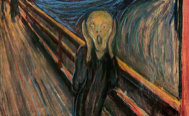
Baroque art is the full expression of the Propagation of faith: Propaganda Fidei, as is written on the house at the Spanish steps from where the Catholic Church is conducting her missionary activity. To understand it better, read my blog in the popup window about Baroque Art, a most modern way of making commercials as add on the television today,

Nativity with the arrival of the Magi, known as the Madonna della Spineta
Giovanni di Pietro, known as "Spagna" 1450-Spoleto 1528
Room 14/15: Genre paintings of the 17th and 18th centuries
We are almost to the end of our tour, and you will notice that people not very often halt in those last rooms of the Pinacoteca. The Vatican itself calls it "Genre paintings". It seems we are coming to a decline in the arts ... and indeed!We are in the 17th/18th centuries. I would say that the Baroque art as the full expression of Propaganda fidei lasted until twenty/thirty years after the Peace of Westphalia-Munster (full text) in 1648. After thirty years of war between Protestants and Catholics, finally their was peace.
The Ratification of the Treaty of Münster, 15 May 1648 (1648) by Gerard ter Borch
A simplified map of Europe after the Peace of Westphalia in 1648.


A devastating war that lasted 80 years between Spain and the Netherlands, finished by the recognition of the latter, the total sovereinty of Swiss and 30 years of religious wars all over Europe came to an official end. The death-toll was immense. "We live like animals, eating bark and grass," says a pitiful entry in a family Bible from a Swabian village. "No one could have imagined that anything like this would happen to us. Many people say that there is no God..." Wenceslas Hollar recorded devastation in the war zone in engravings of the 1630s and starvation reached such a point in the Rhineland that there were cases of cannibalism.
The rectification of the Treaty allowed the rulers of the Imperial States to decide their religious worship. The principle of cuius regio, eius religio. This was already decided by the Peace of Augsburg in 1555, but had remained until then a dead letter. Fabio Chigi, the future pope Alexander VII, was representing as Nuntius in Cologne the pope Innocentius X. It was only through the intrigues of his sister in law, Donna Olimpia Pamphili (La Pimpaccia) that he as simple monk became pope. His whole pontificate was dominated by her. But he was not a match against the most powerful cardinal Mazarin. The peace-treaty also consisted in the rule that minorities (like roman-catholics in many northren countries) could observe in private their religion. Protestants and Catholics became equal before the law ! It was of course a defeat of the papacy, losing it influence over almost half of Europe. In the document Zelo Domus Dei, (Bulla Pontificia adversus Instrumentum Pacis Westphalicæ 26. Nov. 1648.) the pope called it null, void, invalid, iniquitous, unjust, damnable, reprobate, inane, empty of meaning and effect for all time".
Pope Innocence X, Pamphilij, Diego Velàzquez 1650, Galleria Doria Pamphilij - Roma
Cardinal Mazarin Philippe de Champaigne
The money that in the past was used for making war and the propagation of faith, could now be used for the arts. I can imagine that the Pope said: "We don't have to spend anymore money on war, we can use that money for something much better ... let say ... barbecues and parties !!" And the arts are changing. From the high baroque of Bernini and Borromini, we are arriving in the Rococo. It still feels like an over-rich baroque, but is missing the spiritual meaning of it. We are living in the time of the three Musketeers, Versailles, and in Rome: the Trevi Fountain. And look at it: the top is catholic: the tiara of the pope, angels playing music, whatever is below is pagan: goddesses of fertility, scenes of victory, in the middle the God Neptune on the horse with wings ... it's party-time!!



And also the music changed: by reading my weblog, you have had the opportunity to listen in every era the music of it's time. Now it's party time: music of Haendel, and try to listen to the Te Deum of Charpentier (1688-1698), when he was the musical director of the Jesuits in Paris.
The song is called Te Deum ... for "God and the Nation", but clearly, you can hear that the lyrics are far less important than the trumpets and the drums. Was it written to praise the Lord ?? I don't think so. And indeed, even when it is called "For God", it was written to celebrate the battle of Steinkirk in 1692.
Politics changed, architecture changed, music changed ... and of course also the painting art will change. Religious works were only made for people who are already convinced, and had no function of "Propagation of Faith - Propaganda Fidei" anymore. And so, having people who only have to look at their umbilicus or navel, the art was deteriorating. The Vatican itself calls this rooms "Genre-painting", still-lives, ancient Greek and Roman mythology, hunting-scenes and some ??religious works??

I would be very happy to have a renaissance master or a small work of Caravaggio in my living-room, but please, please ... never this ! Can you imagine that I also have curtains with the same flowers and who knows, even my wallpaper. This is hardly worth the value of the canvas on which it was painted ! But yeah, it was only made for people who were already convinced. The catholic church closed itself again in a cocoon of an idealiter world ... and drifted day after day further away from the reality. This neo-platonic Church will endure until the Vatican Council II.
Have also a look at an almost similar painting of The Rest in Egypt that was made in those years. Again the public needed an angel in the background to understand that it is a religious painting. Little by little people became again analfabeth in their faith. Reciting the old catechisms became more important than living faith. The second Word War and the consequent emancipation of men as well of women will make an end to this and with the Vatican Council II, the neoplatonic church of rituals and formalism will come to an end. Unfortunately, often the liturgy got sobered up so much that the transcendency got lost. Today we are seeing again a revival towards a more healthy balance.
Saint Ignatius with ghirlands of flowers
Daniel Seghers e Hendrik Van Balen
Rest in Egypt
Francesco Mancini 1679-1758


Prinny (George IV) was no Mr Darcy: he was very overweight and he must have looked pretty awful in the unforgiving male fashions of the time. His growing obesity made him an ideal target for cartoonists of the day.
George IV by Sir Thomas Lauwrence 1816
We started our journey with the platonic figures of the 14th century, then Madonna's with facelift and botox, then we got to an aristotelian realism with Caravaggio ... and it seems we got back to idealizing the world in the 19th century. Maybe the comparison between King George IV, painted by Sir Thomas Lawrence and the cartoons made of him at the same time shows that there was a lot of plastic surgery, botox or body-lifting before he got to that result. Again we see that painters were free in their style, but at the end have to listen to those who commissioned the works. For Sir Thomas Lawrence, a king is a King and therefore .... perfect !!


The last room, before we are walking out brings us in an idealic zoo. Peter Wenzel (from Karlsbad-Austria) painted Adam and Eve in a beautiful garden with over 200 animals.
It is called "The Garden of Eden", but maybe a better title would be "Five minutes before Twelve o'clock". Isn't it that as soon Adam will eat the forbidden fruit, that the lion will start eating the lam, the snake in the right corner will eat the swan ... and the whole paradise will be destroyed forever !
Adam & Eve in the Paradise
Peter Wenzel 1745-Rome 1829
Room 16: Peter Wenzel

All the life-size animals are made by Peter Wenzel. Why animals, you may ask. But look at the world that surrounded him. All European countries had colonies, and soon Queen Victoria would rule over her Empire, and one of the ways to show that they ruled the waves was creating a zoo.
Just like the presence of the different animals in the Colosseum showed the Romans that the emperor had still a firm grip over the provinces, the zoo's in the capital showed the influence of Europe over the rest of the world. For the same reason they built the Victorian Museums: a cabinet of rarities from all over the world.
Painters like Peter Wenzel, who managed to paint life-size animals were therefore much required.

Queen Victoria on her 66th Birthday
And here ends our journey through the Pinacoteca of the Vatican. I hope you have enjoyed it.
